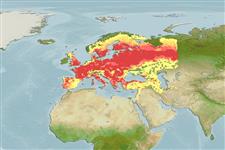Actinopterygii (strålfeniga fiskar) >
Cypriniformes (Carps) >
Cyprinidae (Minnows or carps) > Tincinae
Etymology: Tinca: Latin, timica; realted to a predatory fish = timi, but the etymology of tench does not conform with this meaning (Ref. 45335); tinca: tinca which is the latin name for tench (Ref. 1998).
Miljö / Klimat / Range
Ekologi
; sötvatten; brackvatten bottenlevande; flodvandrande (Ref. 51243); djupintervall 1 - ? m (Ref. 26368). Temperate; 4°C - 24°C (Ref. 13614), preferred ?; 64°N - 36°N, 10°W - 104°E
Eurasia: hypothesized as native in most Europe, naturally absent only in Ireland, Scandinavia north of 61°30'N, eastern Adriatic basin and western and southern Greece where it is now introduced. In Asia, native eastward to western Yenisei drainage south of 60° N. Introduced elsewhere.
Length at first maturity / Size / Vikt / Age
Maturity: Lm ?, range 20 - ? cm
Max length : 70.0 cm SL hane/ej könsbestämd; (Ref. 44894); common length : 20.0 cm TL hane/ej könsbestämd; (Ref. 556); publicerad maxvikt: 7.5 kg (Ref. 556)
Taggstrålar i ryggfenan (totalt): 4; Mjukstrålar i ryggfenan (totalt): 8-9; Taggstrålar i analfenan 3-4; Mjukstrålar i analfenan: 6 - 8; Ryggkotor: 39 - 41. Body thickset, heavy, and laterally compressed, the caudal peduncle characteristically deep and short. Skin thickened, slimy; the scales small, embedded. Overall coloration olive-green, at times dark green or almost black, with golden reflections on ventral surface. Head triangular, eye orange-red, small; snout relatively long; interorbital broad; mouth terminal, small in size with thick lips and a pair of well-developed barbels, one at each corner of the mouth. Caudal fin with 19 rays (Ref. 2196). Diagnosed from other cyprinid species in Europe by the following characters: body golden greenish brown; one pair of barbel (maxillary); lateral line with 96-115 scales, small and deeply embedded; dorsal fin with 8-9½ branched rays; and anal fin with 6-9½ branched rays (Ref. 59043).
Typically found in shallow, densely vegetated lakes and backwaters. Often overwinters buried in mud. Larvae and juveniles confined to dense vegetation (Ref. 59043). Adults inhabit warm lakes and pools with weed and mud bottom. Tolerates low oxygen saturations (Ref. 30578, 44894). Feeds on detritus, benthic animals and plant materials. Adult often prey mainly on molluscs. Spawns among dense vegetation in still water (Ref. 59043). Used as a fodder fish for bass (Ref. 7248). Utilized fresh and frozen; eaten pan-fried, broiled, and baked (Ref. 9988). Popular with amateur sport fishers. Its flesh is highly esteemed (Ref. 30578). Locally under threat due to river engineering (Ref. 59043). Reported to reach a maximum length of 84 cm TL (Ref. 5723).
Males reproduce at 2-3 years and females at 3-7 years. Spawning happens, depending on latitude, between May and September, at temperatures of 19 20°C. Lays numerous sticky green eggs on plants or on the botton every 1 5 days for 2 months. Incubation at 20°C lasts 3 days. Larvae remain attached to the plants for several days until the vitellus is used up. Egg size 0.8-1.0 mm, larval length at hatching 4-5 mm.
Kottelat, M. and J. Freyhof, 2007. Handbook of European freshwater fishes. Publications Kottelat, Cornol and Freyhof, Berlin. 646 pp. (Ref. 59043)
IUCN Red List Status (Ref. 115185)
CITES (Ref. 94142)
Not Evaluated
Threat to humans
Harmless
Human uses
Fiskeri: kommersiell; Vattenbruk: kommersiell; sportfisk: ja; Akvarium: Offentliga akvarier
Verktyg
Special reports
Download XML
Internet-källor
